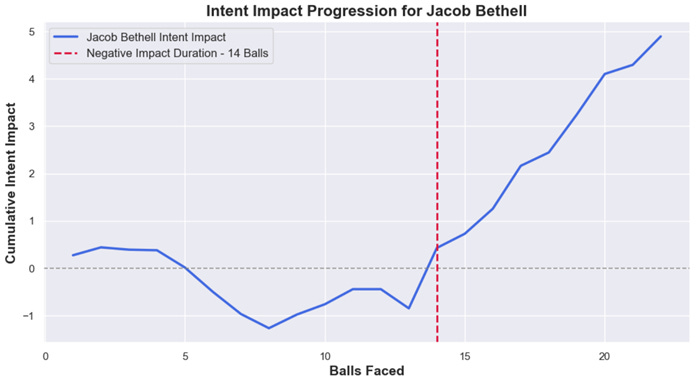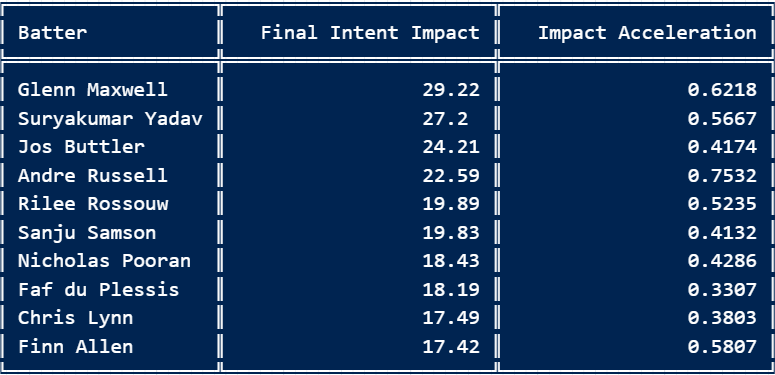T20 cricket batting has reached a point where strike rates are now being shoved down our throats, poems are being written on impact, and good intent has become a boarding pass to play anywhere in the world. But at the same time, it has led to some really interesting questions. Is there a way for us to know how many (or how few) balls a batter needs to play on average for a positive impact knock? How do we know if a batter gains anything from the time he spends at the crease? How can we use intent and impact to comment on batters in different roles or positions? And finally, how much informational juice can we really extract from these two terms?
Let’s have a look.
First of all, we need to see how a batter’s innings progress in terms of intent (which I’m defining as his strike rate with respect to the non-striker). For every ball a batter faces, we need to know how others are playing in the same conditions. The difference between them could be termed intent impact. So, to get the intent impact of a batter, I am comparing every ball played by the batter to the average of balls played by the non-striker just before and after. The difference in runs scored between them is my intent impact. I get an intent impact progression by cumulative addition of all these impacts on each ball.
Now, to study a batter on intent, I’ve identified four key values:
Final Intent Impact – The final cumulative impact the batter finishes with (sum of impacts on all balls)
Impact Acceleration – This is the final intent impact divided by the number of balls, telling us how quickly that impact is created. The value shows how many extra runs are scored by the batter per ball than others batting with him.
Negative Impact Duration – The minimum number of balls a batter needs to face to ensure a positive impact knock. This answers the question of how long (or short) a batter needs to bat that we discussed earlier.
Improvement Metrics – These show how much a batter gains from spending time at the crease. Impact improvement is the difference between the average impact of the final and initial ten balls. Improvement rate is this value divided by the number of balls faced. Improvement percentage is the percentage of balls where impact improves compared to the previous ball (indicating consistency).
The Leaders
Maxwell is the batter with the highest average impact. Andre Russell leads in impact acceleration (Maxwell was second). You’ve got to appreciate these two batters for being on this list despite not really batting in the top order. The acceleration numbers they have really set them apart. Faf du Plessis is another name I think needs a mention because he is generally not talked about enough when it comes to intent. Faf’s skill doesn’t lie in his acceleration; it lies in maintaining decent strike rates for a longer period.
(Data - bbb datasets maintained by Himanish Ganjoo)
As discussed above, I’ve tried to cover all critical pieces of information using these six metrics. These metrics also need to be assigned different levels of importance and weights depending on the role/position in focus. Here are a few observations I made in this analysis that can explain how different metrics can come in handy in different situations:
The reluctant finishers
There are batters to whom we have assigned the finisher's tag. But we never really asked them if they want it. Maybe giving them some time would help? I’ve identified five of them – Rinku Singh, Rahul Tewatia, Sherfane Rutherford, Shahrukh Khan, and Liam Livingstone. These are all players who take between 9 (Livingstone) and 18 (Rutherford) balls to convert into a positive impact innings. In this case, I don’t think batting below number 5 would be ideal for them. The best entry point for these players should be overs 13–14 so that they are set for the last four. There was also a sixth name in David Miller, but teams now don’t really expect him to go from the first ball and have accepted the fact that he takes time. One really good example of a batter benefitting from batting up is Riyan Parag. Parag’s negative impact duration is 7 balls, plus he has a final impact improvement of 1.13 (10th best). This means that if Parag was scoring x runs more per ball than others in his first 10 balls, in the last 10 he scores x+1.13 more. This shows the damage Parag can do if he’s provided with these 7 balls initially.
Just sit back and let them cook
Some openers, you just leave on auto-pilot. They might seem to struggle here and there, but they always end up delivering a high impact if they play long. The top five openers doing this are Jos Buttler, Sanju Samson, Ruturaj Gaikwad, Chris Lynn, and Faf du Plessis. Among these names, Lynn is the only one who takes less than an over to convert to positive. Buttler’s intent impact graph is probably one of the most beautiful sights to wonder at. Once he’s out of the negative zone (8 balls), there’s not a single point where the cumulative impact takes a fall. He shows an impact improvement on 61.4 percent of the balls he faces (4th best). Across all metrics, he’s the one opener who stood out.
Just sit back and let them cook (but sit back longer)
Devon Conway, Kane Williamson, Aaron Finch, D’Arcy Short, Andre Fletcher, and Joe Root are players who will give you a positive knock eventually, but they’ll make you wait long…really long. The risk with these players is them getting out before that time comes. Conway, for example, takes as many as 37 balls for that. Which means he’ll probably end up playing more negative knocks than positive ones. Williamson and Finch still promise an impact greater than 5 after passing that phase, but with others, you would question if it’s worth taking the risk.
Pinch hitting potential?
There are players who are primarily bowlers but possess some talent with the bat. The advantage with them is that you won’t end up sulking if they get out, and if they play 10 balls and connect a few, you get an incredible boost. That has been the idea behind Sunil Narine. But is he the only one? Maybe he is not. But what metric do we look at to decide who could be a good pinch-hitter? I think it should be impact acceleration, as it will give us the information on maximum impact in minimum balls. Rashid Khan, Pat Cummins, Ben Dwarshuis, and Chris Jordan are bowlers (or bowling all-rounders) who are the best when it comes to impact acceleration. We’ve seen a few glimpses of their batting lower down the order, but will any team be adventurous enough to unleash them in the powerplay?
The initial thrust
A different breed of openers from the Buttlers and the Gaikwads is one that likes to go hard early on. Naturally, this affects their impact improvement negatively since it's difficult to sustain those strike rates for longer durations, especially after the powerplay ends. This breed includes players like Jason Roy, Chris Gayle, Ishan Kishan, Yashasvi Jaiswal, and Ben Duckett. And that is why improvement values need a lot of context. If someone is going at an SR of 200 in the powerplay and then follows it up with 180, you wouldn’t mind it on most days, right? The plan with these openers should be to use their maximum potential as early as possible. Buttler and Jaiswal, I think, were probably one of the most incredible pairings ever in T20 because of the way they both operate.
The middle-muddle masters
De Villiers, Riyan Parag, Nicholas Pooran, and Ambati Rayudu are batters who have had impressive impact improvement rates. For middle-order batters, this value becomes important. It ensures you reach a good impact value when the death overs start. It also means you’re constantly improving the run rate in the middle overs. Moeen Ali also ranks pretty well in this aspect, but teams haven’t been sure of his batting abilities in the middle. This is a point I mentioned in one of my earlier pieces as well, because his intent against spin was one of the best.
Thank you for reading till the end. It’s been fun bringing out these ideas and observations. I would love to answer any questions or engage in discussions on this piece. Do subscribe if you like the work!














This is one of your best, Arnav! I love the negative impact duration metric (that you measure in balls) ... and the intent impact progression is a beautiful construct. Wonder what you'll do next ...
Rinku Singh. I remember his knock against Afghanistan when he built the whole innings with Rohit after a collapse.